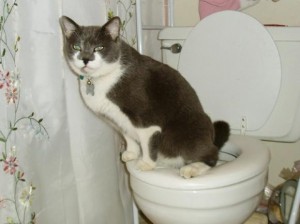Every person seems to have their personal piece of advice involving Don’t flush cat feces down the toilet.

Introduction
As cat owners, it's important to be mindful of just how we take care of our feline pals' waste. While it might appear convenient to purge feline poop down the commode, this practice can have damaging consequences for both the atmosphere and human health and wellness.
Alternatives to Flushing
Luckily, there are more secure and a lot more responsible ways to deal with pet cat poop. Take into consideration the adhering to alternatives:
1. Scoop and Dispose in Trash
One of the most common technique of throwing away cat poop is to scoop it into a naturally degradable bag and throw it in the garbage. Be sure to make use of a specialized trash scoop and dispose of the waste immediately.
2. Use Biodegradable Litter
Go with naturally degradable pet cat litter made from products such as corn or wheat. These trashes are eco-friendly and can be safely disposed of in the trash.
3. Hide in the Yard
If you have a backyard, think about burying cat waste in a designated location away from veggie yards and water sources. Make sure to dig deep sufficient to stop contamination of groundwater.
4. Mount a Pet Waste Disposal System
Buy a pet garbage disposal system specifically created for cat waste. These systems utilize enzymes to break down the waste, reducing smell and ecological influence.
Health Risks
Along with environmental worries, purging pet cat waste can likewise position wellness dangers to people. Cat feces might have Toxoplasma gondii, a parasite that can cause toxoplasmosis-- a potentially severe disease, especially for expectant women and people with weakened immune systems.
Ecological Impact
Flushing cat poop introduces damaging pathogens and bloodsuckers into the water system, posturing a considerable risk to water ecological communities. These pollutants can adversely influence aquatic life and compromise water quality.
Final thought
Liable pet ownership expands beyond supplying food and shelter-- it also includes correct waste management. By refraining from purging cat poop down the toilet and going with alternate disposal methods, we can lessen our environmental footprint and protect human health and wellness.
Why Can’t I Flush Cat Poop?
It Spreads a Parasite
Cats are frequently infected with a parasite called toxoplasma gondii. The parasite causes an infection called toxoplasmosis. It is usually harmless to cats. The parasite only uses cat poop as a host for its eggs. Otherwise, the cat’s immune system usually keeps the infection at low enough levels to maintain its own health. But it does not stop the develop of eggs. These eggs are tiny and surprisingly tough. They may survive for a year before they begin to grow. But that’s the problem.
Our wastewater system is not designed to deal with toxoplasmosis eggs. Instead, most eggs will flush from your toilet into sewers and wastewater management plants. After the sewage is treated for many other harmful things in it, it is typically released into local rivers, lakes, or oceans. Here, the toxoplasmosis eggs can find new hosts, including starfish, crabs, otters, and many other wildlife. For many, this is a significant risk to their health. Toxoplasmosis can also end up infecting water sources that are important for agriculture, which means our deer, pigs, and sheep can get infected too.
Is There Risk to Humans?
There can be a risk to human life from flushing cat poop down the toilet. If you do so, the parasites from your cat’s poop can end up in shellfish, game animals, or livestock. If this meat is then served raw or undercooked, the people who eat it can get sick.
In fact, according to the CDC, 40 million people in the United States are infected with toxoplasma gondii. They get it from exposure to infected seafood, or from some kind of cat poop contamination, like drinking from a stream that is contaminated or touching anything that has come into contact with cat poop. That includes just cleaning a cat litter box.
Most people who get infected with these parasites will not develop any symptoms. However, for pregnant women or for those with compromised immune systems, the parasite can cause severe health problems.
How to Handle Cat Poop
The best way to handle cat poop is actually to clean the box more often. The eggs that the parasite sheds will not become active until one to five days after the cat poops. That means that if you clean daily, you’re much less likely to come into direct contact with infectious eggs.
That said, always dispose of cat poop in the garbage and not down the toilet. Wash your hands before and after you clean the litter box, and bring the bag of poop right outside to your garbage bins.
https://trenchlesssolutionsusa.com/why-cant-i-flush-cat-poop/

Do you really like reading about Can You Flush Cat Poo or Litter Down the Toilet?? Write a review down below. We'd be pleased to know your thoughts about this posting. We hope that you come back again soon. Sharing is caring. You just don't know, you might be helping someone out. Thanks so much for taking the time to read it.
Get Estimate